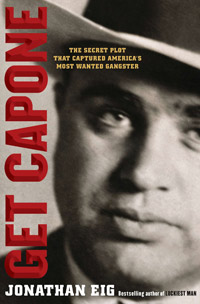Eig debunks myths in his new book about the famous gangster.
 |
TRUE CRIME The May issue of Chicago magazine features a long excerpt about the St. Valentine’s Day Massacre, the gruesome 1929 murders of seven gangsters in a Chicago garage, from a new book about Al Capone. That book, Get Capone: The Secret Plot That Captured America’s Most Wanted Gangster ($28; Simon & Schuster) by the journalist and best-selling author Jonathan Eig, went on sale this past Tuesday—the same day Eig, who lives in Chicago, held the launch party for his book at the Chicago History Museum in Lincoln Park.
In the museum’s auditorium for an audience of history buffs (read: a lot of silver-haired, bespectacled folk), Eig gave a talk in which he debunked some common myths about Capone. "He’s been made into this bogeyman," Eig said. "I think people know Robert DeNiro [who played the gangster in the 1987 film The Untouchables] better than they know Capone." Capone, Eig said, was probably a much more likable person than one might think. And he described the government’s case against the gangster as a tenuous one, in which the feds had to "behave like criminals to catch the criminal"—not the heroic, open-and-shut case portrayed in films.
Eig, who once worked at Chicago magazine as a staff writer, also talked about the three-year research and writing process, during which he says he dreamt about hanging out with Capone, touring the boss’s South Prairie Avenue house, and checking out his cigar collection. The author embarks on his national tour this weekend. But the native New Yorker will be back to give his adopted hometown plenty of love in May and June, giving similar talks at The Hideout and the Printer’s Row Book Fair, among others. Check out his tour dates and listen to Chicago magazine’s editor, Richard Babcock, interview Eig.
GO: May 7 at 6:30 p.m. Free. Jonathan Eig is a guest on The Interview Show. The Hideout, 1354 W Wabansia, 773-227-4433.
WHAT CRITICS HAVE SAID ABOUT GET CAPONE, PLUS RELATED LINKS
- The New York Times review by James McManus, 4/26/2010:
"Eig illuminates the predictable spiral of widely reviled prohibitions. Righteous legislators pass unenforceable laws banning alcohol, marijuana or wagering. Entrepreneurial "benefactors" compete to supply the banned pleasures. Unable to summon the authorities when disputes arise, suppliers are forced to police themselves, making violence inevitable. The top suppliers become so rich, so well armed (tommy guns in the ’20s, jet aircraft and antitank rockets today), they compete with the police on even terms, sometimes to the point where the original prohibition is no longer tenable."
- The Chicago Sun-Times review by Steve Wambir, 4/25/2010:
"He’s wiped away the garbage and given us a man. A brutal, ruthless schemer, to be sure, one who loved to bet on the horses and spend lavishly—and one didn’t hesitate to kill to keep the cash rolling in."
- The Chicago Reader review (second item) by Sam Adams, 4/22/2010:
"The violence never lets up, but Eig also gives us the intimate Capone, who fancied silk underwear, collected elephant figurines, and as an Alcatraz inmate suffering from syphilis-induced dementia wrote love songs on the mandola."
- The book’s website.
- The Chicago Gangland Tour, an iPhone app that Eig put together.
- Eig wrote a tax-day post for The Huffington Post about how tax evasion ultimately landed Capone behind bars, 4/15/2010:
"In 1931, when Al Capone was convicted of income tax evasion and sentenced to 11 years in prison, the legendary gangster complained that he got a raw deal. ‘I’ve never heard of anyone getting more than five years for income tax evasion,’ said the man known as ‘Scarface.’ ‘It’s a blow to the belt.’"
- Pegged to Eig’s book, the Chicago News Cooperative ran a story by Jessica Reaves about tourists’ persistent fascination with the city’s gangster past, 4/22/2010.
"Today, ironically, it is that violence, and the outwardly glamorous lifestyle it spawned, that attracts tourists from around the world, eager to walk in Capone’s macabre footsteps, to Chicago."
Photographs: (thumbnail) Chicago Tribune; courtesy Simon & Schuster


